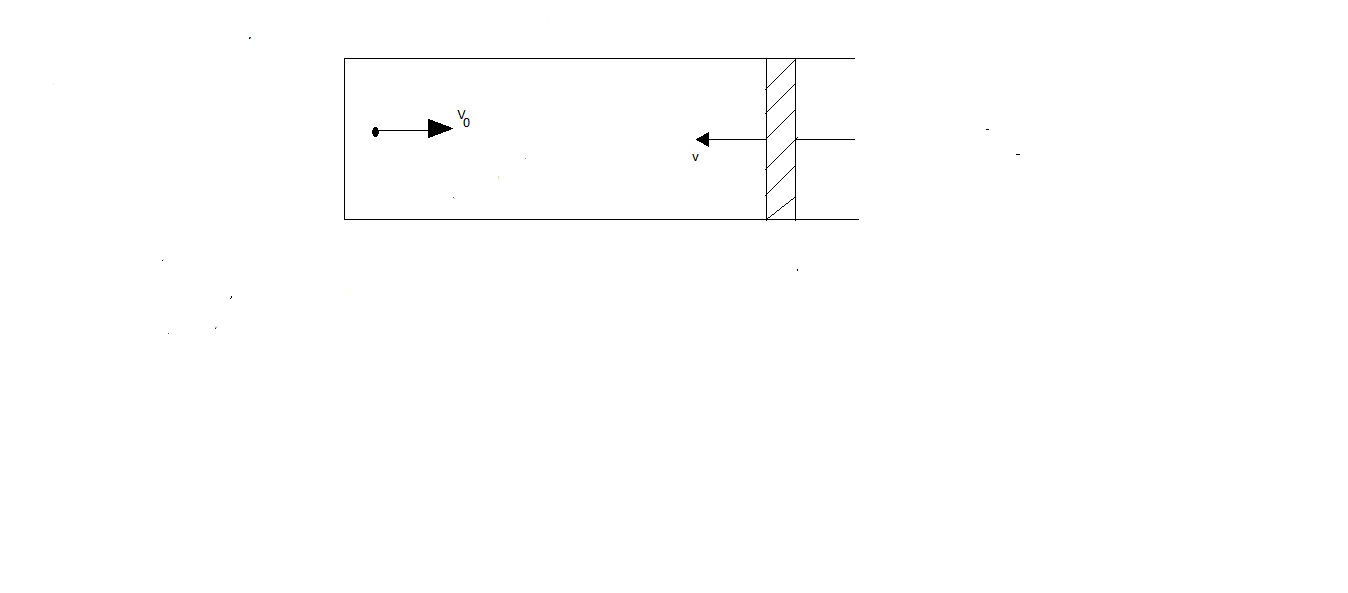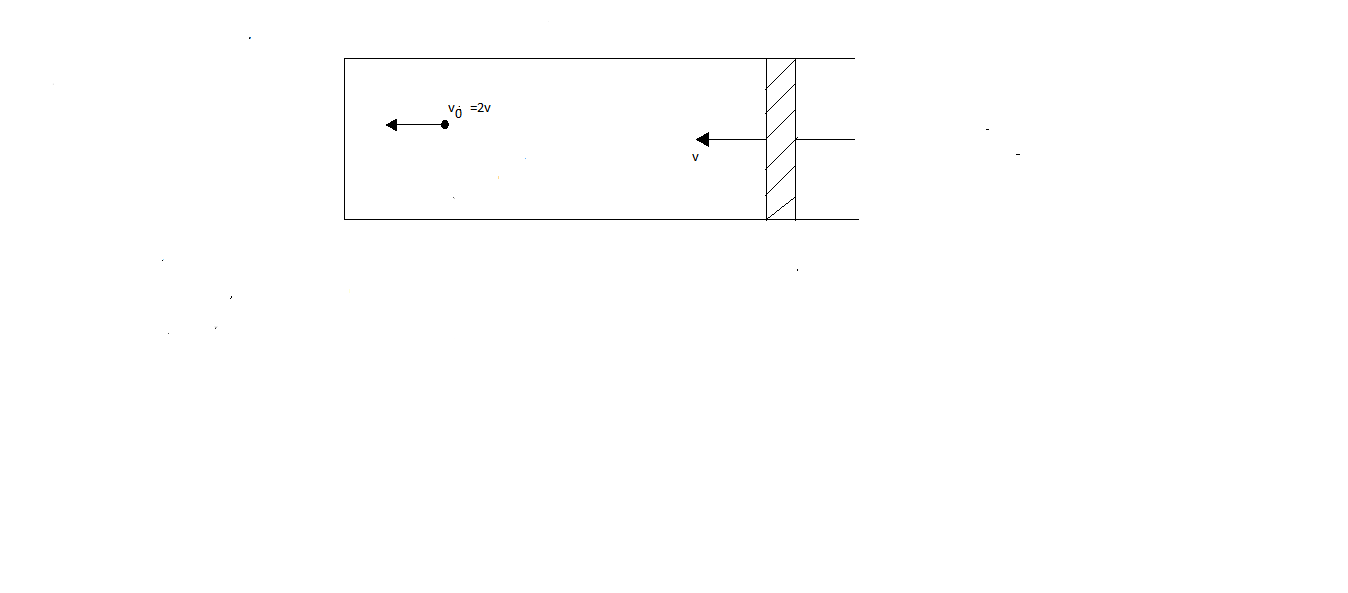
A small particle of mass $ m $ moving inside a heavy, hollow and straight tube along the tube axis undergoes elastic collision at two ends. The tube has no friction and it is closed at one end by a flat surface while the other end is fitted with a heavy movable flat piston as shown in the figure, when the distance of the piston from the closed end is $ L = {L_0} $ the particle speed is $ v = {v_0} $ . The piston is moved inward at a very low speed such that $ V < < \dfrac{{dL}}{L}{v_0} $ . Where $ dL $ is an infinitesimal displacement of the piston.
Which of the following statements is correct?
A. After each collision with the piston, the particle speed increases by $ 2V $
B. If the piston moves inward by $ dL $ , the particle speed increases by $ 2V\dfrac{{dL}}{L} $
C. The particle’s kinetic energy increases by factor of $ 4 $ when the piston is moved inward from $ {L_0} $ to $ \dfrac{1}{2}{L_0} $
D. The rate at which the particle strikes at the piston is $ \dfrac{v}{L} $
Answer
526.8k+ views
Hint :In order to solve this question, we are going to see the conditions before and after the collision and the rate at which a particle hits the piston then, the speed of particle is found from the rate of change of velocity and afterwards the kinetic energies of a particle initially and finally.
The rate of change of velocity is
$ \dfrac{{dv}}{{dt}} = f \times 2V $
Kinetic energy, $ K = \dfrac{1}{2} \times m \times {v^2} $
$ m = mass \\
v = velocity \\ $
Complete Step By Step Answer:
The inferences that can be drawn from the question
Piston before the collision

After the collision,

The rate at which the particle strikes the piston is given by
$ = f = \dfrac{v}{{2x}} $
If $ x = L $ , then, $ f = \dfrac{v}{{2L}} $
The rate of the change of speed of particle is
$ \dfrac{{dv}}{{dt}} = f \times 2V \\
dv = \dfrac{v}{{2x}} \times 2Vdt \\
dv = \dfrac{v}{{2x}} \times 2\left( { - dx} \right) \\ $
Now integrating to find the velocity,
$ \Rightarrow \int\limits_{{v_0}}^v {\dfrac{{dv}}{v} = \int\limits_l^x {\dfrac{{ - dx}}{x}} } \\
\Rightarrow \ln \dfrac{v}{{{v_0}}} = - \ln \dfrac{x}{l} \\
\Rightarrow v = \dfrac{{{v_0}l}}{x} \\ $
Now, taking the case, $ x = \dfrac{{{L_0}}}{2} $
Then, if we find the velocity
$ v = \dfrac{{{v_0}{L_0} \times 2}}{{{L_0}}} $
Now finding the kinetic energy at the value $ x = \dfrac{{{L_0}}}{2} $
$ {K_f} = \dfrac{1}{2} \times m \times 4{v_0}^2 $
Kinetic energy at $ x = {L_0} $
$ {K_i} = \dfrac{1}{2} \times m \times {v_0}^2 $
Therefore, the ratio of the kinetic energies is
$ \dfrac{{{K_f}}}{{{K_i}}} = \dfrac{4}{1} = 4 $
Therefore, the options that are correct are A and C.
Note :
After each collision with the piston, the particles hit the piston with more and more energy that is , the particle speed increases by $ 2V $ and if we find the corresponding particle’s kinetic energy , it increases by factor of $ 4 $ when the piston is moved inward from $ {L_0} $ to $ \dfrac{1}{2}{L_0} $ .
The rate of change of velocity is
$ \dfrac{{dv}}{{dt}} = f \times 2V $
Kinetic energy, $ K = \dfrac{1}{2} \times m \times {v^2} $
$ m = mass \\
v = velocity \\ $
Complete Step By Step Answer:
The inferences that can be drawn from the question
Piston before the collision

After the collision,

The rate at which the particle strikes the piston is given by
$ = f = \dfrac{v}{{2x}} $
If $ x = L $ , then, $ f = \dfrac{v}{{2L}} $
The rate of the change of speed of particle is
$ \dfrac{{dv}}{{dt}} = f \times 2V \\
dv = \dfrac{v}{{2x}} \times 2Vdt \\
dv = \dfrac{v}{{2x}} \times 2\left( { - dx} \right) \\ $
Now integrating to find the velocity,
$ \Rightarrow \int\limits_{{v_0}}^v {\dfrac{{dv}}{v} = \int\limits_l^x {\dfrac{{ - dx}}{x}} } \\
\Rightarrow \ln \dfrac{v}{{{v_0}}} = - \ln \dfrac{x}{l} \\
\Rightarrow v = \dfrac{{{v_0}l}}{x} \\ $
Now, taking the case, $ x = \dfrac{{{L_0}}}{2} $
Then, if we find the velocity
$ v = \dfrac{{{v_0}{L_0} \times 2}}{{{L_0}}} $
Now finding the kinetic energy at the value $ x = \dfrac{{{L_0}}}{2} $
$ {K_f} = \dfrac{1}{2} \times m \times 4{v_0}^2 $
Kinetic energy at $ x = {L_0} $
$ {K_i} = \dfrac{1}{2} \times m \times {v_0}^2 $
Therefore, the ratio of the kinetic energies is
$ \dfrac{{{K_f}}}{{{K_i}}} = \dfrac{4}{1} = 4 $
Therefore, the options that are correct are A and C.
Note :
After each collision with the piston, the particles hit the piston with more and more energy that is , the particle speed increases by $ 2V $ and if we find the corresponding particle’s kinetic energy , it increases by factor of $ 4 $ when the piston is moved inward from $ {L_0} $ to $ \dfrac{1}{2}{L_0} $ .
Recently Updated Pages
Master Class 11 Chemistry: Engaging Questions & Answers for Success

Why are manures considered better than fertilizers class 11 biology CBSE

Find the coordinates of the midpoint of the line segment class 11 maths CBSE

Distinguish between static friction limiting friction class 11 physics CBSE

The Chairman of the constituent Assembly was A Jawaharlal class 11 social science CBSE

The first National Commission on Labour NCL submitted class 11 social science CBSE

Trending doubts
What is meant by exothermic and endothermic reactions class 11 chemistry CBSE

10 examples of friction in our daily life

One Metric ton is equal to kg A 10000 B 1000 C 100 class 11 physics CBSE

Difference Between Prokaryotic Cells and Eukaryotic Cells

What are Quantum numbers Explain the quantum number class 11 chemistry CBSE

1 Quintal is equal to a 110 kg b 10 kg c 100kg d 1000 class 11 physics CBSE




